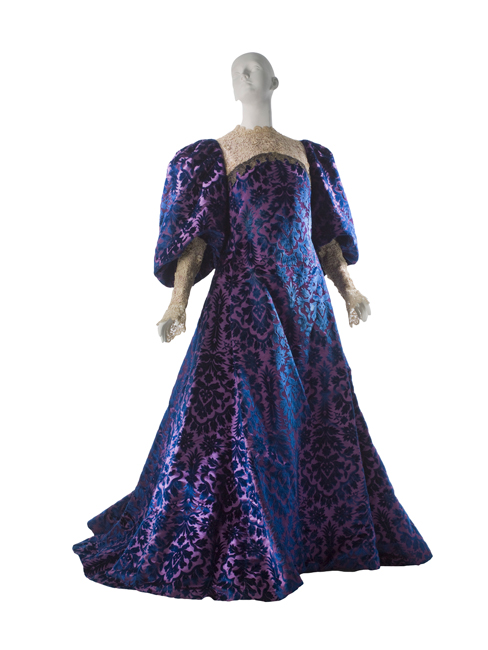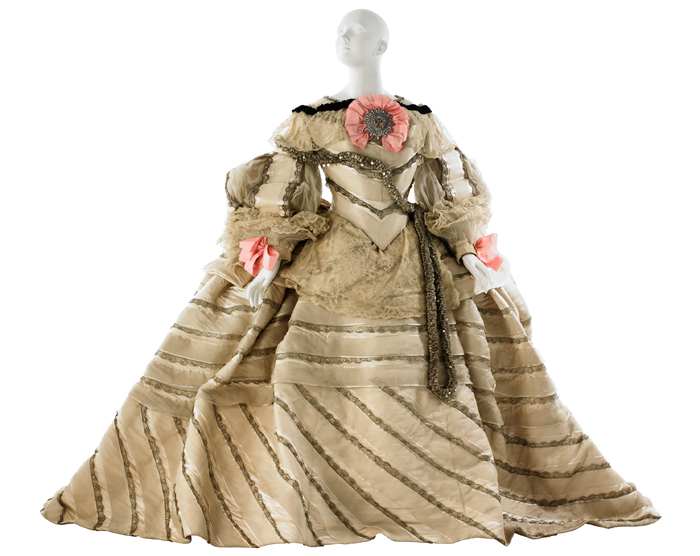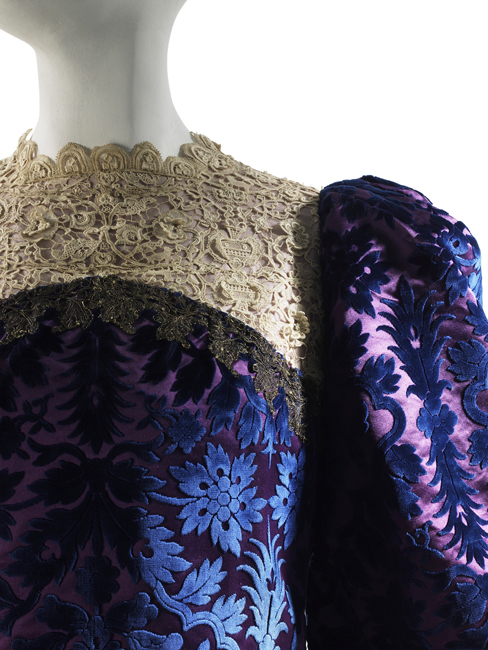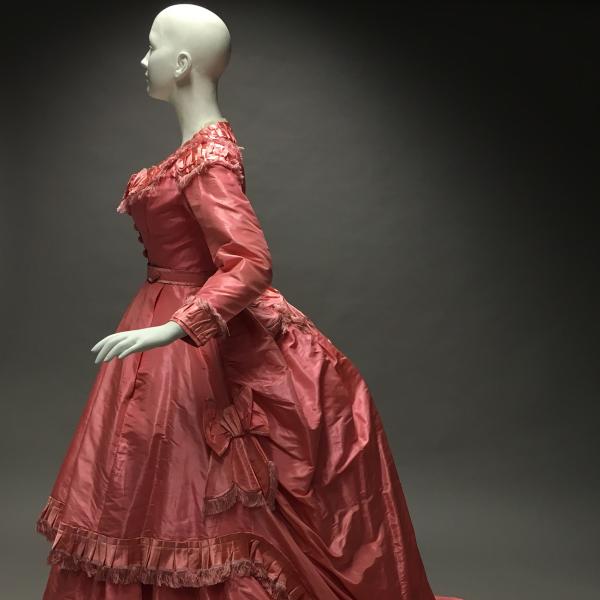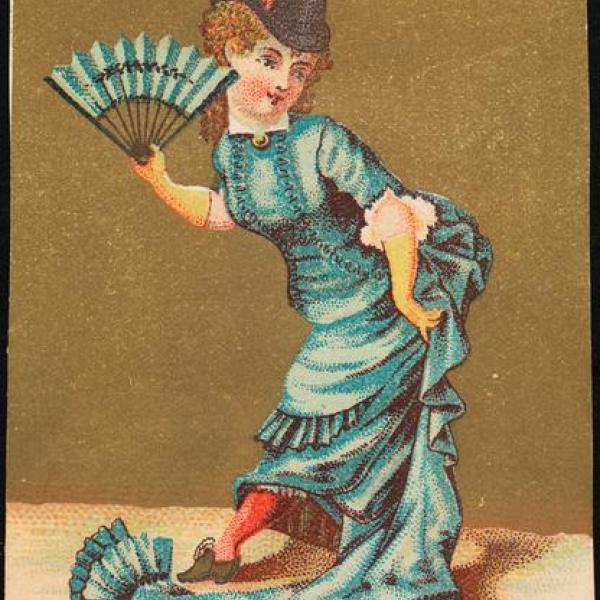Getting Dressed: Gilded Age Tea Dress
Thursday, March 21, 2019 by
It is hard to imagine a woman who more perfectly personifies the figure of the Gilded Age society hostess than Catherine Olivia Meily, Mrs. Calvin Stewart Brice, known to friends as “Liv.” An Ohio native and graduate of Western University at Oxford, OH, she married Mr. Brice—then a struggling lawyer and former Civil War Lieutenant Colonel—in 1869, bearing him three sons and two daughters over the next seven years. In the 1880s, Mr. Brice shrewdly invested and made a fortune in the booming railroad business with the aid of Ohio governor Charles Foster, becoming President of the Lake Erie and Western Railroad. As his fortunes rose, so did his political ambitions; by 1889, he was Chairman of the Democratic National Committee, and he served a term as the United States Senator from Ohio from 1891 to 1897—somewhat controversially, as he had resided in New York City for several years by that point.
Through it all, Mrs. Brice was a consummate social arbiter, ably shepherding sons Stewart (1870–1910), Walter (1874–1926) and John (1877–1927) to respectable careers in the armed services, New York City politics, and the practice of law, despite the penchant of both her eldest and youngest for the company of actresses. From the family’s New York City residence at 693 Fifth Avenue, to the Corcoran house in Washington, DC (where they resided from 1893–1897), and William Waldorf Astor’s Newport cottage “Beaulieu” (rented each summer in the mid-1890s), Mrs. Brice put on a number of spectacular entertainments, always accompanied by her two daughters, Helen Olivia Brice (1871–1950) and Margaret Katherine Brice (1873–1911), known as Kate.
One of these daughters wore the vivid tea gown featured in the Museum’s most recent Getting Dressed video. It has been a part of our collection since 1942 along with several other family garments from the house of Worth, including the so-called “Infanta” fancy dress ensemble worn by Kate at the Bradley Martin Ball of 1897 (seen here being dressed for our Worth/Mainbocher online exhibition).
Originally, it was assumed that all of the Worth garments in the gift belonged to Mrs. Brice—however, the vast difference in size among the dresses, and Mrs. Brice’s famously ample proportions (revealed in photographs and images that appeared in the press) precluded the possibility that all were hers. In 1892, Godey’s magazine called her “imposing in appearance,” but “most gracious and affable,” with soft grey-blue eyes and the complexion of a young girl, adding, “Mrs. Brice dresses with marked richness, and many of her costumes are gorgeous in the extreme.”1 Two of the dresses in the same gift, surely worn by Mrs. Brice, reveal a woman with a 36-inch corseted waist.
This dress is of decidedly daintier proportions, but still luxurious. Unlike most garments designed to be worn during the day at this time, the gown closes at the back, requiring the aid of a servant to dress. The wearer was about 5’4” tall, and had a 23 ¾-inch waist. Originally, the dress’s proportions were even smaller; the lightly boned underbodice has been very carefully let out approximately 4” with the insertion of pink satin ribbons godets.
Panels of velvet float freely from the bust and rear neck to the hem, while the underbodice (of cheery pink silk to match the lining) sat firmly anchored on the hips, allowing the wearer to go without a corset if she so chose. The striking voided velvet, undoubtedly woven in Lyon, also made it a natural choice for the cover of the recent book The House of Worth: The Birth of Haute Couture, profusely illustrated with several other Worth garments from the Museum’s collection.
In 1884, Harper’s Bazar offered a diatribe-cum-history of the afternoon tea and the attire it necessitated, railing against the increasingly elaborate functions that were really “ball[s] by daylight,” and thinly veiled attempts to present daughters clad in lingerie-evoking dresses to eligible bachelors under the guise of casual hospitality. The practice of offering and dressing specially for afternoon tea had supposedly arisen with Princess Alexandra (wife of future King Edward VII) in Great Britain, but Americans—particularly New Yorkers—had quickly adopted the custom, turning it into an opportunity for lavish display and coquettish match making:
It is no longer the elderly lady who presides at the tea-kettle; the tabbies do not make or drink the tea; the younger pussies are the queens of four-o’clock tea. It is whispered that it is a convenient alias for flirtation, or something even sweeter—that many engagements have been made at “four-o’clock teas.”2
Consequently, “Tea gowns in France, under the régime of Worth, have become most luxurious garments,” made of expensive silks and typically dripping with a profusion of lace, a nod to the garment’s “déshabillé” origins.3
Helen or Kate could have worn this dress to afternoon tea, but also to one of the many semi-informal at-home entertainments staged by their mother, no doubt with the intention of securing them suitable husbands. In late 1892, Senator and Mrs. Brice introduced Kate to society with an elaborate tea at their Washington residence. Mrs. Brice received guests in a gown of plum satin brocaded in gold, while the debutante wore ivory satin and sister Helen donned a “pearl-gray bengaline with large puffed sleeves of scarlet velvet, over which was a fall of Irish point.”4 Yet it was in Newport where Mrs. Brice’s power as a stylish and raucous emcee was on full display. In August 1895, Mrs. Brice hosted “the most elaborate lawn party ever given in Newport” at Beaulieu for 350 of her closest friends. Entertainments included dancing, a dog circus, a gypsy fortune teller, and a mesmerist.5 The following year, she introduced Newport to bawdy vaudevillian performers such as Irish-American Maggie Cline, known as “The Bowery Brunhilde,” and the buxom Canadian “Coon Shouter” May Irwin, who repeated her rendition of I Want You, Ma Honey five times by popular demand.”6 In 1898, Mrs. Brice made news by introducing “dance recitals” as a new form of diversion, which became an immediate, if short-lived, sensation.7
The Brices spent each summer in Europe, traveling and ordering clothes, before heading to Newport late in the season. In 1896, the New York World reported on the twenty wealthiest and most eligible Newport “maidens,” including Miss Helen O. Brice and Miss M. Kate Brice, who were surely among the thirteen on the list then in Europe who would “return at the height of the Newport season, their trunks laden with the latest Parisian frocks and hats.” The Misses Brice “are more cosmopolitan than other heiresses likely to be at Newport this season,” and were expected to inherit some $8 million between them, “and perhaps more.”8
Tea gowns such as this were considered opportunities to announce the wearer’s particular good taste and artistic knowledge. Often, as here, taking direct inspiration from historical modes and Old Master paintings, they were a means of expressing individuality, health, and vigor, in their typically soft materials and less restrictive construction. “Could anything be daintier, more entirely artistic, and therefore attractive, than, for instance, the Worth tea gown on the front page,” asked Harper’s Bazar in 1893, adding, “One sees there that a living, breathing woman wear that bewitching costume; that her toilette adorns her as its plumage a bird, its coloring a flower. And a glance at this beautiful design confirms one in the impression that in these days women allow full play to the organs of vitality, that their muscles are strong and rounded, that their lungs are used to deep inspirations of pure air.” “Fragility,” the magazine concluded, “thank Heaven, is out of fashion.”9
The luxurious simplicity and theatrical historicism of the dress was perfectly in line with the designer, Jean-Philippe Worth’s prevailing aesthetic philosophy for women’s dress. He became the head designer of the house founded by his father following the elder Worth’s death in 1895, though he had taken over much of the design responsibilities for the firm long before. As he later wrote, he abhorred “the tendency of this age to mere glitter and show and novelty for mere sake of novelty,” with materials like “galon, fringe, tassels, and fur” mixed together to form “a motif as tawdry as it is pretentious, vulgar as it is hideous.”10 Calling himself an artist, he believed, “The world’s great picture-galleries, where the priceless portraits painted by the old masters are hung, are the most inspiring sources to which a designer of modes can repair.”11
Most tea gowns made reference to seventeenth and eighteenth century styles, but the conceit of this dress is entirely Renaissance. More specifically, the vibrant patterned silk velvet, square neckline with shallow peak at the center, and enormous balloon sleeves, mime details of Venetian dress from the early sixteenth century, mixed with a bit of Northern European modesty in the form of the lace partlet or yoke over the bust and shoulders. The exceptionally fine machine lace imitating needle lace from the island of Burano contributes to the overall “Venetian” effect.
No doubt inspired by a painted portrait (perhaps by Agnolo Bronzino or Pontormo), the gown—and by extension, its wearer—would have been recognized at the time as markedly “artistic,” especially when viewed in comparison with the more frothy, coquettish, and lingerie-like tea gowns of Rococo inspiration. An appreciation of sweeping Italian Renaissance styles had been nurtured by English pre-Raphaelite artists such as Edward Burne-Jones, whose 1860 watercolor depicting Jane Morris in the guise of literary heroine Sidonie von Bork features a costume of similar silhouette magnificence, a decided contrast to the tightly corseted silhouette in vogue for fashionable attire.
Unfortunately it is impossible to say which of the Misses Brice wore this particular dress. The “Infanta” costume, which we know was worn by Kate, has a 24-inch waist, not far from the tea gown’s size, although the proportions of the fancy dress indicate are stouter. Helen’s 1908 likeness by John Singer Sargent (who had painted her father) showcases a more conventional white chiffon or mousseline toilette, and a shawl that was one of the artist’s favorite studio props obscures much of her physiognomy. Despite Mrs. Brice’s best efforts, both of her daughters remained unmarried, living independently as socialites and philanthropists in Manhattan. Kate died in 1911 at age 37; her brother John named his daughter, born the following year, in her honor. Her estate by this time was worth somewhat less than estimated in 1896, at about $467,000, including a diamond dog collar worth $10,000 (roughly $250,000 today).12 Helen continued to reside at the family home at 693 Fifth Avenue until 1912, when she bought a vacant plot of land at 95th Street and built a new mansion (693 became the site of the Richard Hudnut salons in 1931).13 She continued to summer in Newport well into her 70s, occupying the Bancroft or the Baldwin cottages. In January 1950, she died at her home on 960 Fifth Avenue, having outlived her parents and siblings.14 Like all the Brices, she is buried in the family mausoleum in Lima, OH.
This Gilded Age Tea Dress is featured in our Getting Dressed video series, a behind-the-scenes look at the dazzling, fascinating, and surprising to be found in the Museum’s costume & textiles collection. Watch more from the series.
